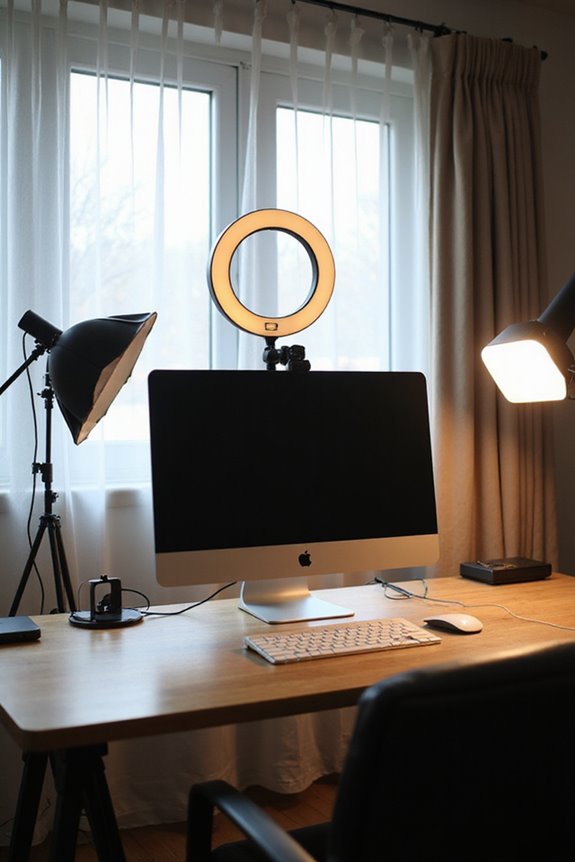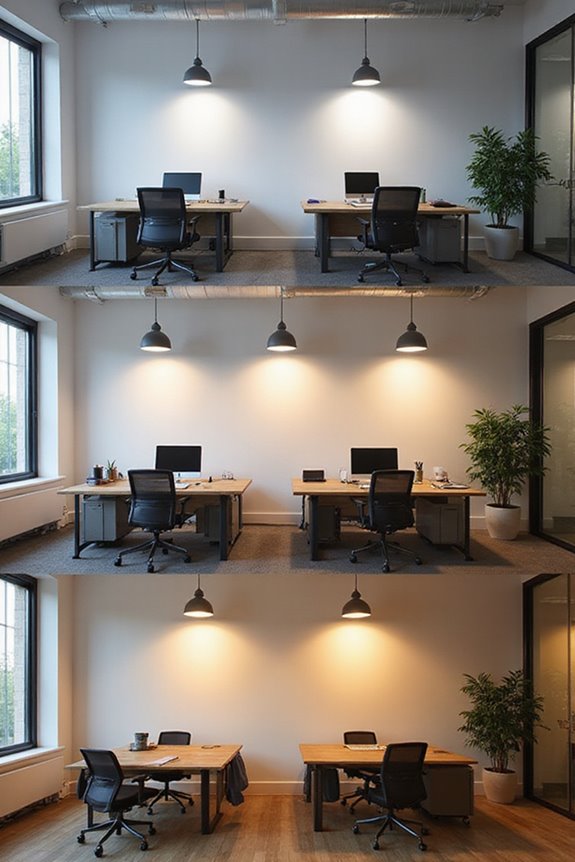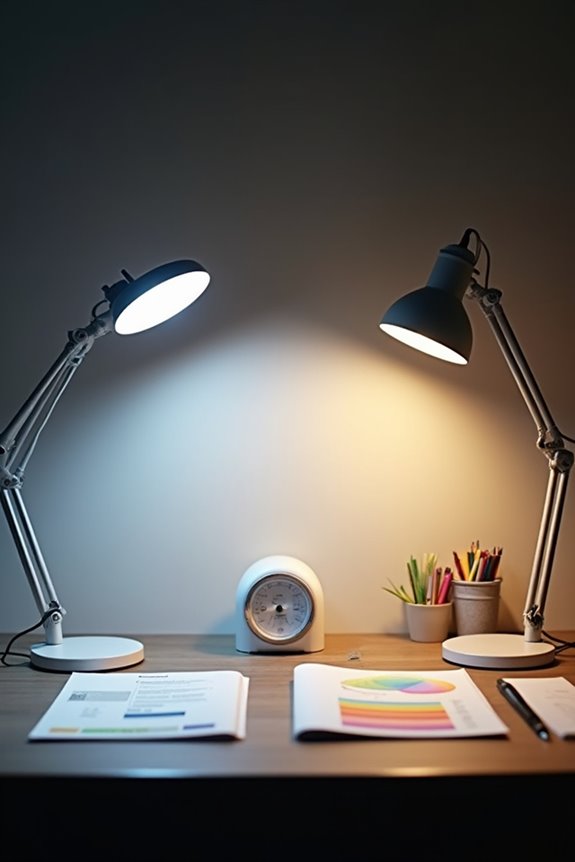For the best lighting setup in video calls, I’ll position my key light at a 30 to 45-degree angle to my face, using a brightness of 600–800 lumens. I’ll aim for a color temperature of 5600K for flattering skin tones. Utilizing natural light from a window is beneficial, but I avoid backlighting. Adding a fill light softens shadows, and keeping the environment uncluttered focuses attention. This foundational knowledge helps guarantee I’m well-lit and engaging on camera. There’s more to explore on enhancing your video call experience.
Key Takeaways
- Position the key light at a 30 to 45-degree angle to the face for optimal illumination and to avoid harsh shadows.
- Use a color temperature between 5000K to 6500K, ideally 5600K, for flattering skin tones and balanced appearance.
- Incorporate fill light opposite the key light to soften shadows and achieve balanced lighting for video calls.
- Utilize natural light by facing a window while using sheer curtains to diffuse harsh sunlight for a softer effect.
- Keep the background uncluttered to maintain focus on the speaker, enhancing the overall visual appeal of the call.
Understanding Key Light for Video Calls
When setting up for video calls, understanding the role of key light is fundamental for achieving professional-looking illumination. Key light positioning is significant; I recommend placing the light at a 30 to 45-degree angle to your face to avoid harsh shadows. Direct frontal lighting can be too intense and unflattering.
In terms of key light intensity, aim for a brightness of 600–800 lumens, which is generally sufficient for most settings. Adjusting the brightness based on your ambient lighting is essential to maintain a balanced look. Using energy-efficient LED lights not only saves power but also guarantees durability. Experiment with angles and intensities until you find the perfect setup that highlights your features effectively during video calls.
Choosing the Right Color Temperature
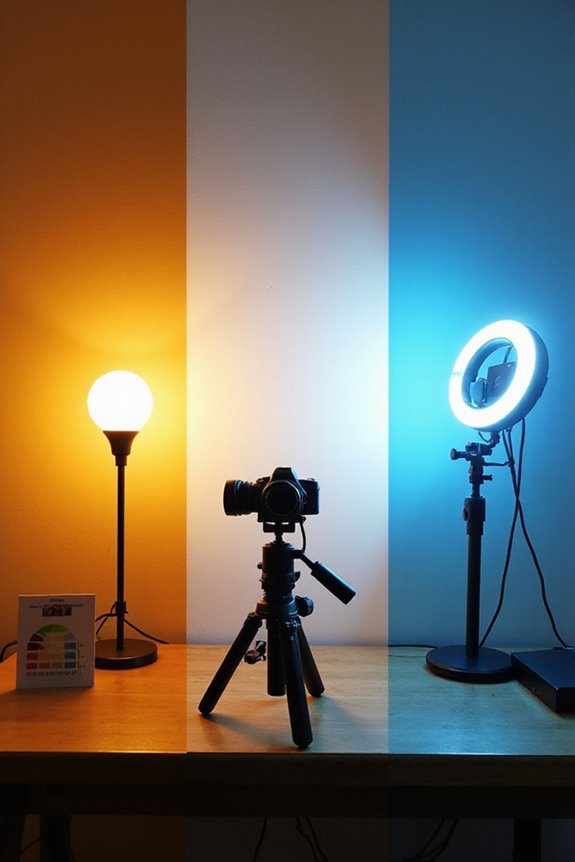
Understanding color temperature is essential for enhancing your video call experience, as it greatly impacts how you appear on screen. The ideal color temperature range for video calls is between 5000K and 6500K, which mimics natural daylight. I’ve found that around 5600K is best for achieving a balanced appearance that flatters skin tones without distortion. Lower temperatures can create an overly warm, orangish hue, while higher temperatures might introduce harsh, bluish tones that emphasize imperfections. It’s important to customize your lighting, as different skin tones respond uniquely to color temperature. By experimenting within this range, you can find the perfect setting that maintains a true-to-life representation, ensuring a professional and engaging video call.
Utilizing Natural Light Effectively
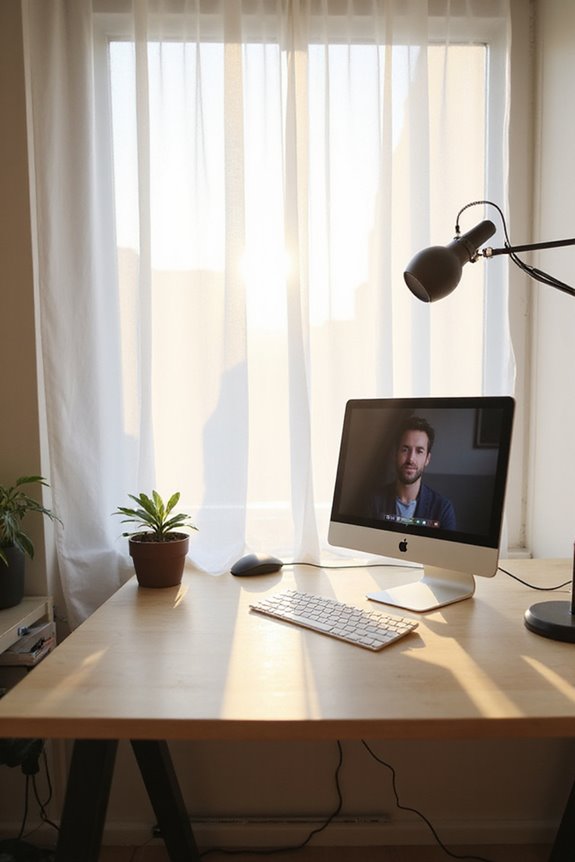
How can you make the most of natural light during video calls? First, position yourself to face the window directly or at a slight angle. This helps illuminate your face evenly, minimizing shadows. Be cautious of placing the window behind you, as it creates backlighting and a silhouette effect. For ideal light diffusion, use sheer curtains to soften harsh light, especially during midday when sunlight can be too intense. Adjust your seating throughout the day to maintain consistent lighting, as window angles and light intensity change. Finally, consider light-colored backgrounds that reflect natural light, enhancing the overall brightness of your video without distraction. These simple adjustments can greatly improve your video call quality.
Incorporating Fill Light for Balance

Incorporating fill light into your video call setup can greatly enhance the overall quality of your image, making it more visually appealing. The primary purpose of fill light is to soften shadows created by your key light, ensuring a balanced illumination on your face. For ideal fill light positioning, place it at the same angle as your key light but on the opposite side of the camera. This setup helps reduce harsh shadows, improving the overall look of your video. If you’re looking for fill light alternatives, consider using a monitor by increasing its brightness and displaying a white screen. This budget-friendly option can effectively serve as fill light, enhancing your video call experience without breaking the bank.
Optimizing Room Lighting and Environment
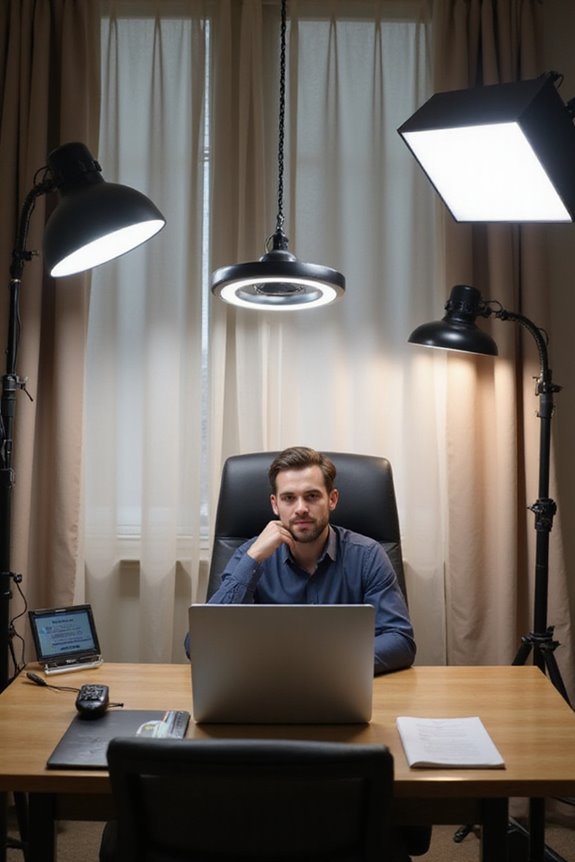
Optimizing your room lighting and environment can greatly enhance your video call experience. Proper light positioning is essential; I recommend placing your main light source in front of you or at a 45-degree angle. This setup minimizes shadows, creating even illumination across your face. Avoid overhead and backlighting, as they can produce unflattering shadows.
Utilizing natural light can also improve your appearance. Position yourself near a window, ensuring the light isn’t too harsh by using sheer curtains. Additionally, adjust brightness and color temperature to suit your skin tone. Keeping your background uncluttered and minimal helps maintain focus on you. By implementing these strategies, you’ll achieve a professional look that’s ideal for video conferencing.
Essential Lighting Tools and Gadgets
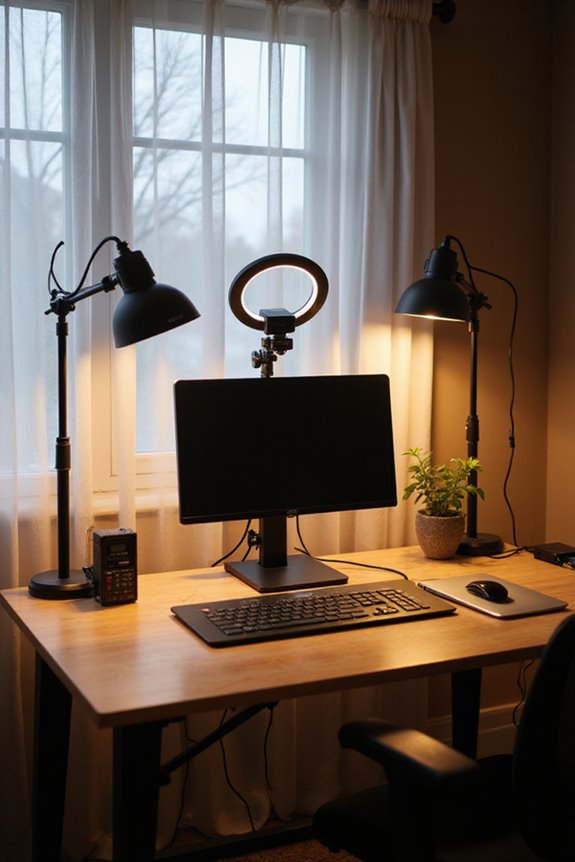
When you’re setting up for video calls, the right lighting tools can make all the difference in how you appear on camera. Here are some essential gadgets to take into account:
- Ring Lights: These provide even, diffused lighting, minimizing shadows. With adjustable brightness and color temperature, they’re versatile and easy to mount.
- Panel Lights: Compact and lightweight, panel lights offer directional illumination and customizable settings, making them ideal for a professional appearance.
- LED Desk Lamps: These allow flexible positioning and adjustable brightness, enhancing visibility while saving desk space.
- Video Conference Lighting Kits: All-in-one solutions guarantee quick setup and consistent results.
- Smart Lights: Automated adjustments and app control help optimize your lighting effortlessly.
Investing in these tools can elevate your video call experience considerably.
Adjusting Your Setup for Different Times of Day

Adjusting your video call setup throughout the day can greatly enhance your on-camera presence, especially since natural light varies considerably. In the morning, I recommend positioning my setup to face north or south, avoiding harsh east or west sunlight. This creates softer lighting, ideal for morning adjustments.
As the day progresses, midday light can be intense, often requiring me to supplement with artificial sources. Using diffusers can help mimic that softer, more flattering effect. For evening setups, I focus on warmer artificial lights to match the natural glow during sunset, ensuring my skin tone looks pleasing. Regularly checking my lighting throughout the day keeps my appearance professional and consistent.
Frequently Asked Questions
How Can I Avoid Glare From My Glasses During Calls?
Oh, the relentless glare! To conquer it, I adjust my lighting angles, placing lights at 45 degrees, ensuring soft illumination. This glare reduction transforms my video calls into a radiant experience, free from distracting reflections.
What Are the Best Lighting Setups for Different Skin Tones?
When choosing lighting color, I’ve found that cooler tones around 5000K work best for warmer skin tones, while warmer tones near 3500K suit cooler tones. Adjusting these can really enhance your appearance during calls.
Can I Use Colored Lights for Video Calls?
I wouldn’t recommend using colored lights for video calls. While they create interesting colored light effects and mood lighting, they can appear unprofessional and distract from your message. Stick with neutral lighting for a polished look.
How Do I Reduce Shadows on My Face?
To chase away shadows like clouds on a sunny day, I use shadow elimination techniques. I find face lighting angles that soften harshness, ensuring my features shine brightly without distractions. It’s all about balance and placement!
What Should I Wear to Complement My Lighting Setup?
When dressing for video calls, I always consider color coordination and fabric choices. Neutral tones or soft pastels work well, and I opt for smooth fabrics to minimize distractions and guarantee I look my best on camera.

